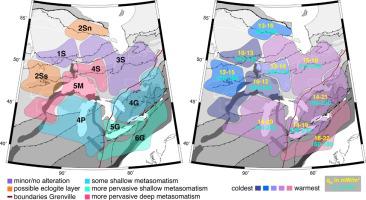当前位置:
X-MOL 学术
›
Earth Planet. Sci. Lett.
›
论文详情
Our official English website, www.x-mol.net, welcomes your
feedback! (Note: you will need to create a separate account there.)
Thermo-compositional structure of the north-eastern Canadian Shield from Rayleigh wave dispersion analysis as a record of its tectonic history
Earth and Planetary Science Letters ( IF 4.8 ) Pub Date : 2020-10-01 , DOI: 10.1016/j.epsl.2020.116465 Isabella Altoe , Thomas Eeken , Saskia Goes , Anna Foster , Fiona Darbyshire
Earth and Planetary Science Letters ( IF 4.8 ) Pub Date : 2020-10-01 , DOI: 10.1016/j.epsl.2020.116465 Isabella Altoe , Thomas Eeken , Saskia Goes , Anna Foster , Fiona Darbyshire

|
Abstract The thermal and compositional structure of lithospheric keels underlying cratons, which are stable continental cores formed during the Precambrian, is still an enigma. Mapping lithospheric temperatures and compositional heterogeneities is essential to better understand geodynamic processes that control craton formation and evolution. Here we investigate the northeastern part of North America which comprises the Superior Craton, the largest Archean craton in the world, and surrounding Proterozoic belts. We model Rayleigh-wave dispersion curves from a previous study, which were regionalised based on cluster analysis. Next, we perform a grid search for sub-crustal thermal and compositional structures that are consistent with the average dispersion curve for each cluster. We apply constraints on crustal structure and use thermodynamic methods to map thermo-compositional structures into seismic velocity. In agreement with previous studies, most regions require concentrations of metasomatic minerals over certain depth intervals to fit the seismic profiles. Our results further require vertical as well as lateral variations in compositional and thermal structures, which appear to reflect different stages of formation and modification of the lithosphere below the region, with distinct structures found under Archean cores, Archean/Paleoproterozoic collision belts, mid-late Proterozoic collision belts, and zones affected by rifting.
中文翻译:

来自瑞利波频散分析的加拿大东北部地盾的热成分结构作为其构造历史的记录
摘要 前寒武纪形成的稳定大陆核心——克拉通下伏的岩石圈龙骨的热结构和成分结构仍然是一个谜。绘制岩石圈温度和成分异质性对于更好地了解控制克拉通形成和演化的地球动力学过程至关重要。在这里,我们调查了北美的东北部,其中包括世界上最大的太古代克拉通上级克拉通和周围的元古代带。我们对先前研究中的瑞利波频散曲线进行建模,这些曲线基于聚类分析进行了区域化。接下来,我们对与每个集群的平均分散曲线一致的亚地壳热和成分结构进行网格搜索。我们对地壳结构施加约束,并使用热力学方法将热成分结构映射到地震速度。与先前的研究一致,大多数地区需要在一定深度间隔内的交代矿物浓度才能拟合地震剖面。我们的结果进一步需要成分和热结构的垂直和横向变化,这似乎反映了该地区下方岩石圈形成和修改的不同阶段,在太古代核心、太古代/古元古代碰撞带、中晚期发现了不同的结构。元古代碰撞带和受裂谷影响的区域。大多数地区需要在一定深度间隔内集中交代矿物,以适应地震剖面。我们的结果进一步需要成分和热结构的垂直和横向变化,这似乎反映了该地区下方岩石圈形成和修改的不同阶段,在太古代核心、太古代/古元古代碰撞带、中晚期发现了不同的结构。元古代碰撞带和受裂谷影响的区域。大多数地区需要在一定深度间隔内集中交代矿物,以适应地震剖面。我们的结果进一步需要成分和热结构的垂直和横向变化,这似乎反映了该地区下方岩石圈形成和修改的不同阶段,在太古代核心、太古代/古元古代碰撞带、中晚期发现了不同的结构。元古代碰撞带和受裂谷影响的区域。
更新日期:2020-10-01
中文翻译:

来自瑞利波频散分析的加拿大东北部地盾的热成分结构作为其构造历史的记录
摘要 前寒武纪形成的稳定大陆核心——克拉通下伏的岩石圈龙骨的热结构和成分结构仍然是一个谜。绘制岩石圈温度和成分异质性对于更好地了解控制克拉通形成和演化的地球动力学过程至关重要。在这里,我们调查了北美的东北部,其中包括世界上最大的太古代克拉通上级克拉通和周围的元古代带。我们对先前研究中的瑞利波频散曲线进行建模,这些曲线基于聚类分析进行了区域化。接下来,我们对与每个集群的平均分散曲线一致的亚地壳热和成分结构进行网格搜索。我们对地壳结构施加约束,并使用热力学方法将热成分结构映射到地震速度。与先前的研究一致,大多数地区需要在一定深度间隔内的交代矿物浓度才能拟合地震剖面。我们的结果进一步需要成分和热结构的垂直和横向变化,这似乎反映了该地区下方岩石圈形成和修改的不同阶段,在太古代核心、太古代/古元古代碰撞带、中晚期发现了不同的结构。元古代碰撞带和受裂谷影响的区域。大多数地区需要在一定深度间隔内集中交代矿物,以适应地震剖面。我们的结果进一步需要成分和热结构的垂直和横向变化,这似乎反映了该地区下方岩石圈形成和修改的不同阶段,在太古代核心、太古代/古元古代碰撞带、中晚期发现了不同的结构。元古代碰撞带和受裂谷影响的区域。大多数地区需要在一定深度间隔内集中交代矿物,以适应地震剖面。我们的结果进一步需要成分和热结构的垂直和横向变化,这似乎反映了该地区下方岩石圈形成和修改的不同阶段,在太古代核心、太古代/古元古代碰撞带、中晚期发现了不同的结构。元古代碰撞带和受裂谷影响的区域。











































 京公网安备 11010802027423号
京公网安备 11010802027423号